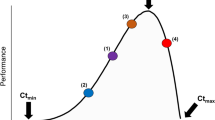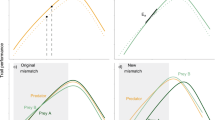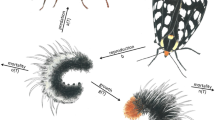Abstract
Temperature is one of the most important environmental parameters influencing all the biological processes and functions of poikilothermic organisms. Although extensive research has been carried out to evaluate the effects of temperature on animal life histories and to determine the upper and lower temperature thresholds as well as the optimal temperatures for survival, development, and reproduction, few studies have investigated links between thermal window, metabolism, and trophic interactions such as predation. We developed models and conducted laboratory experiments to investigate how temperature influences predator–prey interaction strengths (i.e., functional response) using a ladybeetle larva feeding on aphid prey. As predicted by the metabolic theory of ecology, we found that handling time exponentially decreases with warming, but—in contrast with this theory—search rate follows a hump-shaped relationship with temperature. An examination of the model reveals that temperature thresholds for predation depend mainly on search rate, suggesting that predation rate is primarily determined by searching activities and secondly by prey handling. In contrast with prior studies, our model shows that per capita short-term predator–prey interaction strengths and predator energetic efficiency (per capita feeding rate relative to metabolism) generally increase with temperature, reach an optimum, and then decrease at higher temperatures. We conclude that integrating the concept of thermal windows in short- and long-term ecological studies would lead to a better understanding of predator–prey population dynamics at thermal limits and allow better predictions of global warming effects on natural ecosystems.




Similar content being viewed by others
References
Bale JS (2002) Insects and low temperatures: from molecular biology to distributions and abundance. Philos Trans R Soc Lond B 357:849–862
Benton AH, Crump AJ (1981) Observations on the spring and summer behavior of the 12-spotted ladybird beetle, Coleomegilla maculata (Degeer) (Coleoptera: Coccinellidae). J NY Entomol S 89:102–108
Bolker BM (2008) Ecological models and data in R. Princeton University Press, Princeton
Briere J, Pracros P, Le Roux A, Pierre J (1999) A novel rate model of temperature-dependent development for arthropods. Environ Entomol 28:22–29
Brose U, Williams RJ, Martinez ND (2006) Allometric scaling enhances stability in complex food webs. Ecol Lett 9:1228–1236
Brown JH, Gillooly JF, Allen AP, Savage VM, West GB (2004) Toward a metabolic theory of ecology. Ecology 85:1771–1789
Carter MC, Sutherland D, Dixon AFG (1984) Plant structure and the searching efficiency of coccinellid larvae. Oecologia 63:394–397
Cave RD, Gaylor MJ (1989) Functional response of Telenomus reynoldsi [Hym.: Scelionidae] at five constant temperatures and in an artificial plant arena. Biocontrol 34:3–10
Davis JA, Radcliffe EB, Ragsdale DW (2006) Effects of high and fluctuating temperatures on Myzus persicae (Hemiptera: Aphididae). Environ Entomol 35:1461–1468
Dixon AFG, Jarošik V, Honĕk A (2005) Thermal requirements for development and resource partitioning in aphidophagous guilds. Eur J Entomol 102:407–411
Dixon AFG, Honĕk A, Keil P, Kotela MAA, Šizling AL, Jarošik V (2009) Relationship between the minimum and maximum temperature thresholds for development in insects. Funct Ecol 23:257–264
Eggleston DB (1990) Behavioural mechanisms underlying variable functional responses of blue crabs, Callinectes sapidus feeding on juvenile oysters, Crassostrea virginica. J Anim Ecol 59:615–630
Elliott NC, Kieckhefer RW, Beck DA (2000) Adult coccinellid activity and predation on aphids in spring cereals. Biol Control 17:218–226
Englund G, Ohlund G, Hein CL, Diehl S (2011) Temperature dependence of the functional response. Ecol Lett 14:914–921
Firlej A, Chouinard G, Coderre D (2006) A meridic diet for the rearing of Hyaliodes vitripennis (Hemiptera: Miridae), a predator of mites in apple orchards. Biocontrol Sci Techn 16:743–751
Flinn PW (1991) Temperature-dependent functional response of the parasitoid Cephalonomia waterstoni (Gahan) (Hymenoptera: Bethylidae) attacking rusty grain beetle larvae (Coleoptera: Cucujidae). Environ Entomol 20:872–876
Gillooly JF, Brown JH, West GB, Savage VM, Charnov EL (2001) Effects of size and temperature on metabolic rate. Science 293:2248–2251
Giroux S, Duchesne RM, Coderre D (1995) Predation of Leptinotarsa decemlineata (Coleoptera: Chrysomelidae) by Coleomegilla maculata (Coleoptera: Coccinellidae): comparative effectiveness of predator developmental stages and effect of temperature. Environ Entomol 24:748–754
Gordon RD (1985) The coccinellidae (Coleoptera) of America north of Mexico. J NY Entomol S 96:1–912
Gresens SE, Cothran ML, Thorp JH (1982) The influence of temperature on the functional response of the dragonfly Celithemis fasciata (Odonata: Libellulidae). Oecologia 53:281–284
Hoekman D (2010) Turning up the heat: temperature influences the relative importance of top-down and bottom-up effects in pitcher plant inquiline communities. Ecology 91:2819–2825
Holling CS (1959) Some characteristics of simple types of predation and parasitism. Can Entomol 91:385–398
Honĕk A (1985) Activity and predation of Coccinella septempunctata adults in the field (Col., Coccinellidae). Z Angew Entomol 100:399–409
Jalali MA, Tirry L, Arbab A, De Clercq P (2010a) Temperature-dependent development of the two-spotted ladybeetle, Adalia bipunctata, on the green peach aphid, Myzus persicae, and a factitious food under constant temperatures. J Insect Sci 10:1536–2442
Jalali MA, Tirry L, De Clercq P (2010b) Effect of temperature on the functional response of Adalia bipunctata to Myzus persicae. Biocontrol 55:261–269
Jeschke JM, Kopp M, Tollrian R (2002) Predator functional responses: discriminating between handling and digesting prey. Ecol Monogr 72:95–112
Jones TH, Thompson LJ, Lawton JH, Bezemer TM, Bardgett RD, Blackburn TM, Bruce KD, Cannon PF, Hall GS, Hartley SE (1998) Impacts of rising atmospheric carbon dioxide on model terrestrial ecosystems. Science 280:441–443
Juliano SA (2001) Nonlinear curve fitting: predation and functional response curve. In: Scheiner SM, Gurevitch J (eds) Design and analysis of ecological experiments. Chapman & Hall, New York, pp 178–196
Mack TP, Smilowitz Z (1982) Using temperature-mediated functional response models to predict the impact of Coleomegilla maculata (DeGeer) adults and 3rd-instar larvae on green peach aphids. Environ Entomol 11:46–52
Menon A, Flinn PW, Dover BA (2002) Influence of temperature on the functional response of Anisopteromalus calandrae (Hymenoptera: Pteromalidae), a parasitoid of Rhyzopertha dominica (Coleoptera: Bostrichidae). J Stored Prod Res 38:463–469
Messenger PS (1968) Bioclimatic studies of the aphid parasite Praon exsoletum. I. Effects of temperature on the functional response of females to varying host densities. Can Entomol 100:728–741
Obrycki JJ, Tauber MJ (1978) Thermal requirements for development of Coleomegilla maculata (Coleoptera: Coccinellidae) and its parasite Perilitus coccinellae (Hymenoptera: Braconidae). Can Entomol 110:407–412
Obrycki JJ, Ormord AM, Giles KL (1997) Partial life table analysis for larval Coleomegilla maculata (Degeer) and Coccinella septempunctata L. (Coleoptera: Coccinellidae) in alfalfa. J Kansas Entomol Soc 70:339–346
Omkar AP (2004) Temperature-dependent development and immature survival of an aphidophagous ladybeetle, Propylea dissecta (Mulsant). J Appl Entomol 128:510–514
Ongagna P, Giuge L, Iperti G, Ferran A (1993) Cycle de developpement d’Harmonia axyridis (Col. Coccinellidae) dans son aire d’introduction: le Sud-Est de la France. Biocontrol 38:125–128
Persson L (1986) Temperature-induced shift in foraging ability in two fish species, roach (Rutilus rutilus) and perch (Perca fluviatilis): implications for coexistence between poikilotherms. J Anim Ecol 55:829–839
Persson L, Leonardsson K, de Roos AM, Gyllenberg M, Christensen B (1998) Ontogenetic scaling of foraging rates and the dynamics of a size-structured consumer-resource model. Theor Popul Biol 54:270–293
Petchey OL, McPhearson PT, Casey TM, Morin PJ (1999) Environmental warming alters food web structure and ecosystem function. Nature 402:69–72
Petchey OL, Brose U, Rall BC (2010) Predicting the effects of temperature on food web connectance. Philos Trans R Soc Lond B 365:2081–2091
Peters RH (1986) The ecological implications of body size. Cambridge University Press, Cambridge
Portner HO, Farrell AP (2008) Physiology and climate change. Science 322:690
Portner HO, Bennett AF, Bozinovic F, Clarke A, Lardies MA, Lucassen M, Pelster B, Schiemer F, Stillman JH (2006) Trade-offs in thermal adaptation: the need for a molecular to ecological integration. Physiol Biochem Zool 79:295–313
Rall B, Guill C, Brose U (2008) Food web connectance and predator interference dampen the paradox of enrichment. Oikos 117:202–213
Rall BC, Vucic-Pestic O, Ehnes RB, Emmerson M, Brose U (2010) Temperature, predator–prey interaction strength and population stability. Glob Change Biol 16:2145–2157
Rogers D (1972) Random search and insect population models. J Anim Ecol 41:369–383
Savage VM, Gillooly JF, Woodruff WH, West GB, Allen AP, Enquist BJ, Brown JH (2004) The predominance of quarter power scaling in biology. Funct Ecol 18:257–282
Schanderl H, Ferran A, Larroque MM (1985) Les besoins trophiques et thermiques des larves de la coccinelle Harmonia axyridis Pallas. Agronomie 5:417–421
Soares AO, Coderre D, Schanderl H (2003) Effect of temperature and intraspecific allometry on predation by two phenotypes of Harmonia axyridis Pallas (Coleoptera: Coccinellidae). Environ Entomol 32:939–944
Thompson DJ (1978) Towards a realistic predator-prey model: the effect of temperature on the functional response and life history of larvae of the damselfly, Ischnura elegans. J Anim Ecol 47:757–767
Vasseur DA, McCann KS (2005) A mechanistic approach for modeling temperature-dependent consumer-resource dynamics. Am Nat 166:184–198
Voigt W, Perner J, Davis AJ, Eggers T, Schumacher J, Bahrmann R, Fabian B, Heinrich W, Kohler G, Lichter D (2003) Trophic levels are differentially sensitive to climate. Ecology 84:2444–2453
Vucic-Pestic O, Rall BC, Kalinkat G, Brose U (2010) Allometric functional response model: body masses constrain interaction strengths. J Anim Ecol 79:249–256
Vucic-Pestic O, Ehnes RB, Rall BC, Brose U (2011) Warming up the system: higher predator feeding rates but lower energetic efficiencies. Glob Change Biol 17:1301–1310
West GB, Brown JH, Enquist BJ (1997) A general model for the origin of allometric scaling laws in biology. Science 276:122–126
Williams RJ, Martinez ND (2004) Limits to trophic levels and omnivory in complex food webs: theory and data. Am Nat 163:458–468
**a JY, Van der Werf W, Rabbinge R (1999) Temperature and prey density on bionomics of Coccinella septempunctata (Coleoptera: Coccinellidae) feeding on Aphis gossypii (Homoptera: Aphididae) on cotton. Environ Entomol 28:307–314
**a JY, Rabbinge R, Van der Werf W (2003) Multistage functional responses in a ladybeetle aphid system: scaling up from the laboratory to the field. Environ Entomol 32:151–162
Zamani AA, Talebi AA, Fathipour Y, Baniameri V (2006) Temperature-dependent functional response of two aphid parasitoids, Aphidius colemani and Aphidius matricariae (Hymenoptera: Aphidiidae), on the cotton aphid. J Pest Sci 79:183–188
Acknowledgments
We thank J. Doyon, C. Beaudoin, and M. Bélanger-Morin for technical assistance, two anonymous reviewers for very helpful suggestions and comments, and L. Devine for English revision. This work was supported by the Natural Sciences and Engineering Research Council of Canada.
Author information
Authors and Affiliations
Corresponding author
Additional information
Communicated by Sven Bacher.
Rights and permissions
About this article
Cite this article
Sentis, A., Hemptinne, JL. & Brodeur, J. Using functional response modeling to investigate the effect of temperature on predator feeding rate and energetic efficiency. Oecologia 169, 1117–1125 (2012). https://doi.org/10.1007/s00442-012-2255-6
Received:
Accepted:
Published:
Issue Date:
DOI: https://doi.org/10.1007/s00442-012-2255-6




